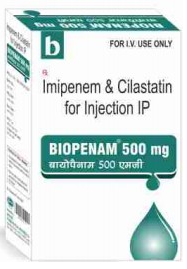Imipenem acts as an antimicrobial through the inhibition of cell wall synthesis of various gram-positive and gram-negative bacteria. This inhibition of cell wall synthesis in gram-negative bacteria is attained by binding to penicillin binding proteins (PBPs). In E. coli and selected strains of P. aeruginosa, imipenem has shown to have the highest affinity to PBP-2, PBP-1a, and PBP-1b. This preferential binding to PBP-2 and PBP-1b results in the direct conversion of the individual cell to a spheroblast, which leads to rapid cell lysis and death without filament formation.
Cilastatin is a specific and reversible renal dehydropeptidase-I inhibitor. Since the antibiotic, imipenem, is hydrolyzed by dehydropeptidase-I, which resides in the brush border of the renal tubule, cilastatin is administered with imipenem to block the metabolism and thus the inactivation of imipenem so that antibacterial levels of imipenem can be attained in the urine. The drug also prevents the metabolism of leukotriene D4 to leukotriene E4 through the inhibition of leukotriene D4 dipeptidase.




Reviews
There are no reviews yet.